About two-thirds of Republicans say the U.S. has controlled the outbreak as much as it could have; 88% of Democrats disagree
How we did this
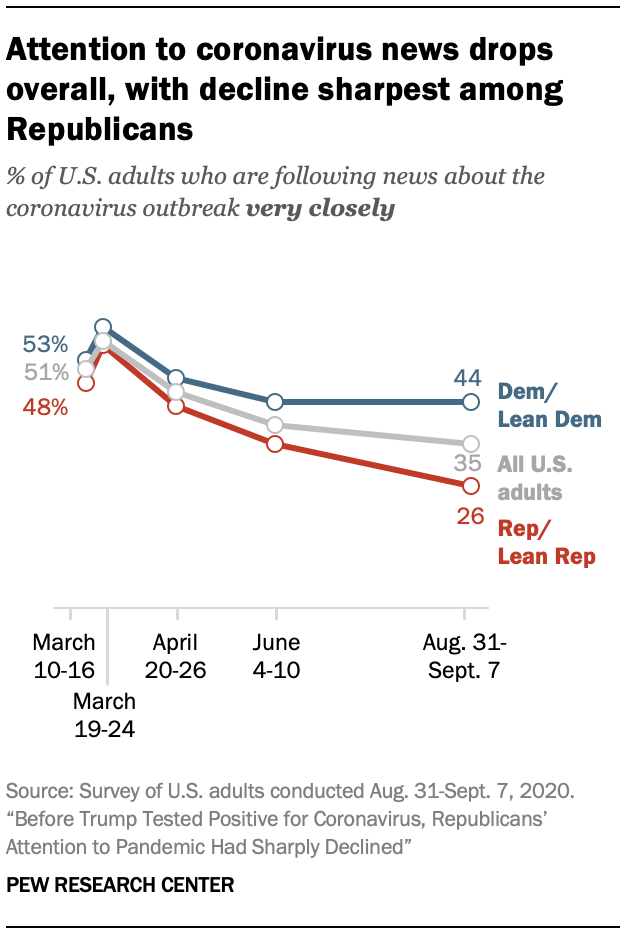 Six months into a pandemic that has claimed more than 200,000 lives in the United States and profoundly impacted daily life – and before President Donald Trump tested positive for the coronavirus – about six-in-ten Americans say the country has not controlled the coronavirus outbreak as much as it could have. At the same time, about four-in-ten also believe that the outbreak has been made into a bigger deal than it really is.
Six months into a pandemic that has claimed more than 200,000 lives in the United States and profoundly impacted daily life – and before President Donald Trump tested positive for the coronavirus – about six-in-ten Americans say the country has not controlled the coronavirus outbreak as much as it could have. At the same time, about four-in-ten also believe that the outbreak has been made into a bigger deal than it really is.
On these two issues, there is deep disagreement between Democrats and Republicans. And within the GOP, opinions vary considerably based on where people get their political and election news, according to a survey of 9,220 U.S. adults conducted Aug. 31-Sept. 7, 2020 (prior to the first presidential debate and Trump’s subsequent positive test for the virus) as part of Pew Research Center’s American News Pathways project.
For example, Republicans and those who lean toward the GOP are much more likely than Democrats and Democratic leaners to say the U.S. coronavirus outbreak has been controlled as much it could have and that it has been overblown. And among Republicans, those who cited Fox News and/or talk radio as their only major sources among eight sources asked about are far more likely than others to take these positions.
Meanwhile, Americans’ attention to coronavirus news has declined, from a high of 57% following that news very closely in late March to 35% who say the same in September. And the degree of attention that Americans are paying to news about the coronavirus also reveals partisan differences, with substantially fewer Republicans now following that coverage closely than Democrats.
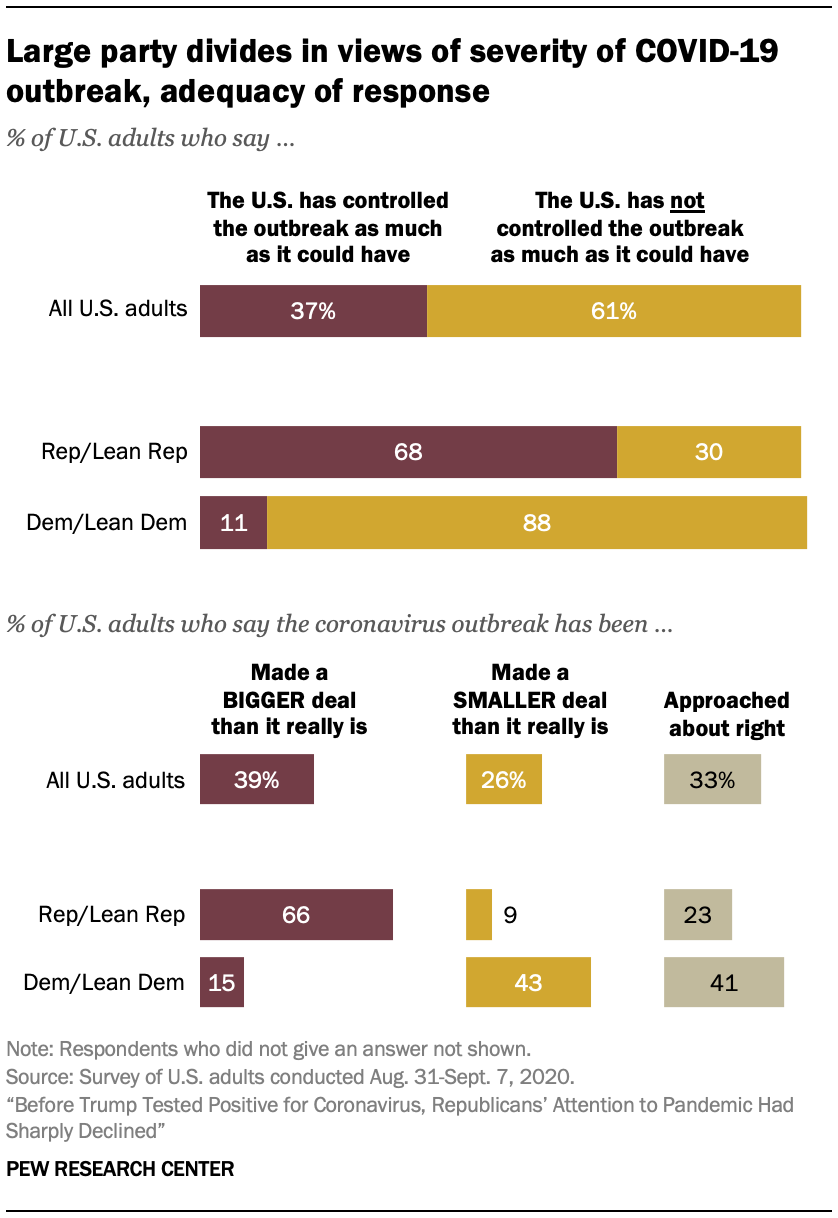 While those partisan differences were small in previous months, that gap has since grown significantly. As of early September, 44% of Democrats are following news of the outbreak very closely, compared with 26% of Republicans.
While those partisan differences were small in previous months, that gap has since grown significantly. As of early September, 44% of Democrats are following news of the outbreak very closely, compared with 26% of Republicans.
Major partisan gaps on key perceptions of the pandemic; among Republicans, large differences by media diet
Overall, 61% of adults say the U.S. has not controlled the COVID-19 outbreak as much as it could have, compared with 37% who say it has. Inside those numbers is a stark partisan divide: About two-thirds of Republicans and independents who lean Republican (68%) say the U.S. has done about as much as it could in controlling the outbreak. That view is held by only about one-in-ten Democrats, including independents who lean Democratic (11%).
But even as most Americans say the outbreak has not been controlled to the extent it could have been, a plurality (39%) believes the pandemic has been made into a bigger deal than it really is. That compares with 26% of Americans who say it has gotten less attention than it should, and 33% who say it has received about the right amount of attention.
Those numbers have not changed much since June. But in April, when the outbreak was still in its early weeks in the U.S., a plurality (42%) said that it had been approached about right, while roughly equal shares thought it had been exaggerated (29%) or underplayed (27%).
On this question, too, there is a major difference by party affiliation, with Republicans much more likely than Democrats – 66% vs. 15% – to say the outbreak has been overblown. Conversely, 43% of Democrats say the pandemic has been made into a smaller deal than it really is, compared with only 9% of Republicans. Another 41% of Democrats say it has been approached about right, compared with 23% of Republicans. These same patterns existed when Americans were surveyed on the subject earlier this year.
Among Republicans, there also are major differences based on media diet.
The survey asked respondents whether each of eight news providers was a major source of political and election news for them. Researchers then grouped these responses based on the political composition of the outlets’ audiences. For example, Republicans were analyzed based on the degree to which they get political news from the outlets with conservative-leaning audiences (specifically, Fox News and talk radio), and Democrats were categorized based on the degree to which they get news from the outlets with liberal-leaning audiences – CNN, MSNBC, NPR, The New York Times and The Washington Post. (The eighth source, national network TV such as ABC, NBC or CBS, has an audience that does not lean strongly in either direction; see Appendix and the box below for more details about how respondents were grouped by their major news sources.)
Partisans’ major news sources
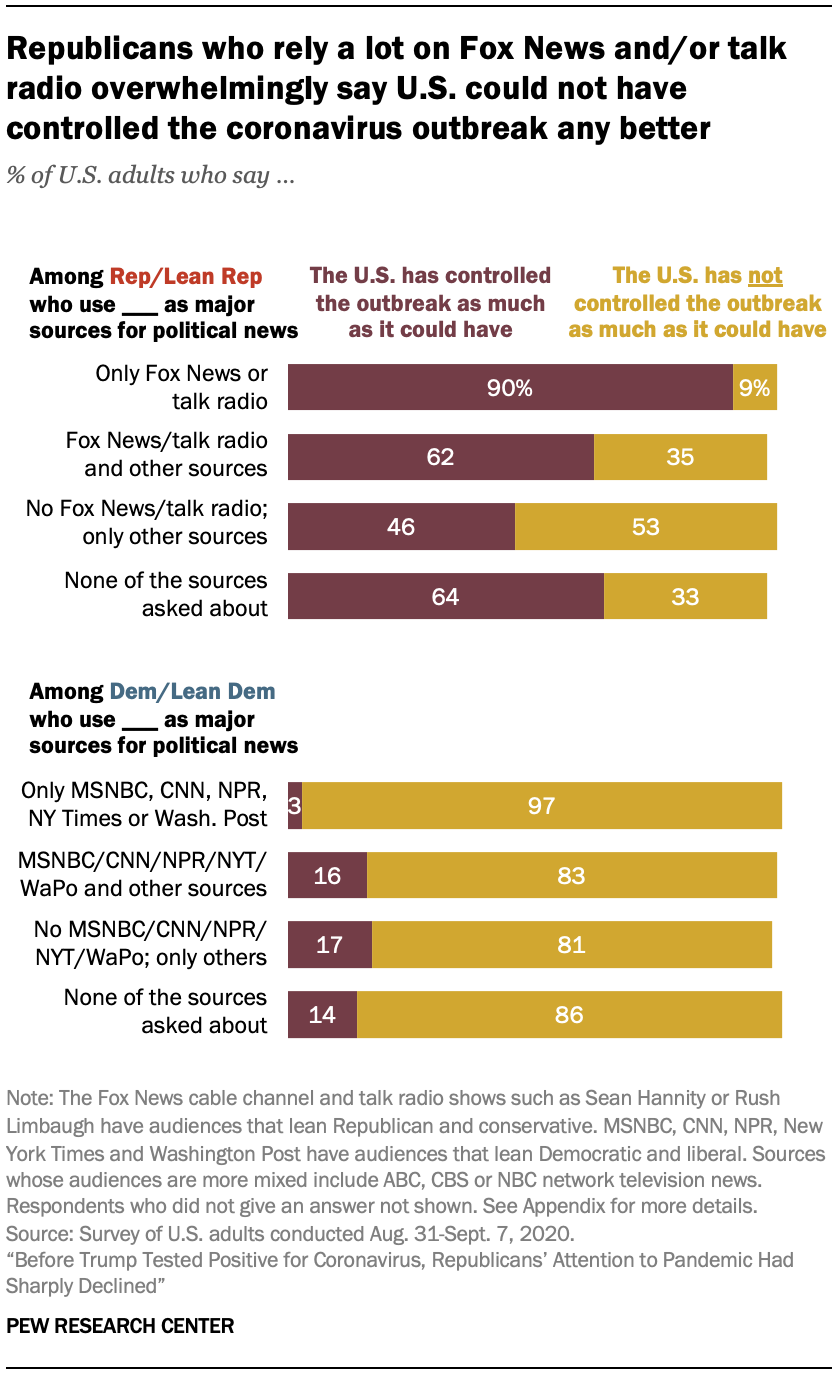 Fully 90% of those Republicans who only indicated Fox News and/or talk radio – two platforms with conservative-leaning audiences – as major sources of political news say the country has controlled the outbreak as much as it could. But among Republicans who rely on neither Fox News nor talk radio but rely on at least one of the other major news providers mentioned in the survey, about half as many (46%) say the U.S. controlled the outbreak as well as it could.
Fully 90% of those Republicans who only indicated Fox News and/or talk radio – two platforms with conservative-leaning audiences – as major sources of political news say the country has controlled the outbreak as much as it could. But among Republicans who rely on neither Fox News nor talk radio but rely on at least one of the other major news providers mentioned in the survey, about half as many (46%) say the U.S. controlled the outbreak as well as it could.
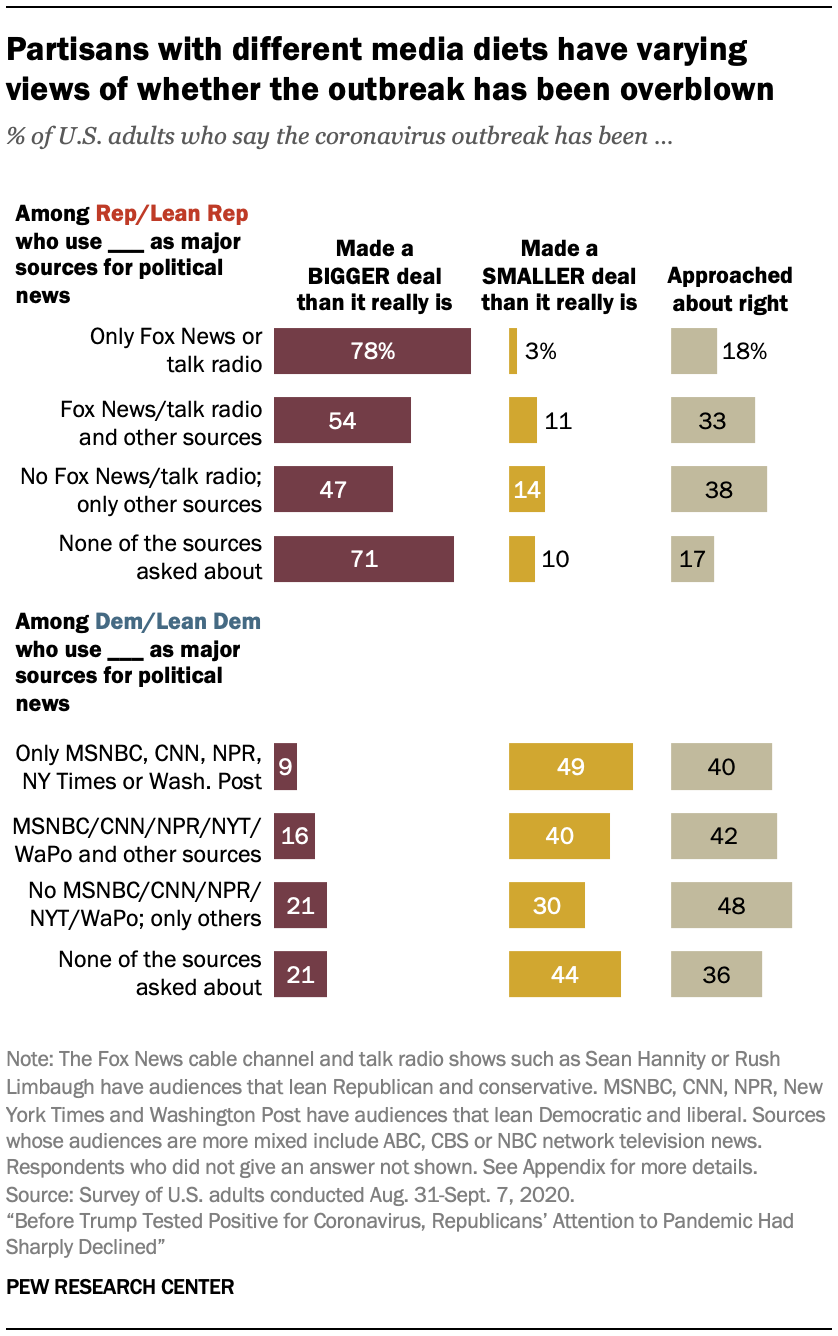 There are far smaller differences among Democrats with different media diets; large majorities in all cases say that the U.S. could have done more to control the outbreak. But unlike other groups, Democrats whose major sources are only those with liberal-leaning audiences – MSNBC, CNN, NPR, The New York Times and The Washington Post – are almost unanimous in saying that the U.S. has not controlled the outbreak as much as it could have (97%).
There are far smaller differences among Democrats with different media diets; large majorities in all cases say that the U.S. could have done more to control the outbreak. But unlike other groups, Democrats whose major sources are only those with liberal-leaning audiences – MSNBC, CNN, NPR, The New York Times and The Washington Post – are almost unanimous in saying that the U.S. has not controlled the outbreak as much as it could have (97%).
There are similar patterns on the question about whether the pandemic has been overblown. As of early September, among Republicans with only Fox News and/or talk radio as major news sources, 78% say the coronavirus has been made a bigger deal than it really is. That falls to 54% among Republicans who use a mix of major sources, and 47% for those who name some major sources, but not Fox News or talk radio.
These patterns do not necessarily prove that Republicans are taking their cues directly from their news sources. Other factors beyond media diet may impact people’s assessments of how the U.S. has reacted to the outbreak. And the relationship can go in either direction: People can either pick their media sources to fit their existing political views, or have their views shaped by those sources (or both at the same time). Still, the data shows a clear connection between news diet within the GOP and views on the pandemic.
These within-party differences hold true even when accounting for ideology. For example, conservative Republicans who only rely on Fox News or talk radio are more likely than conservative Republicans who also rely on other major sources to say that the U.S. has controlled the outbreak as much as it could have.
Republicans paying less attention to news about the coronavirus outbreak than Democrats
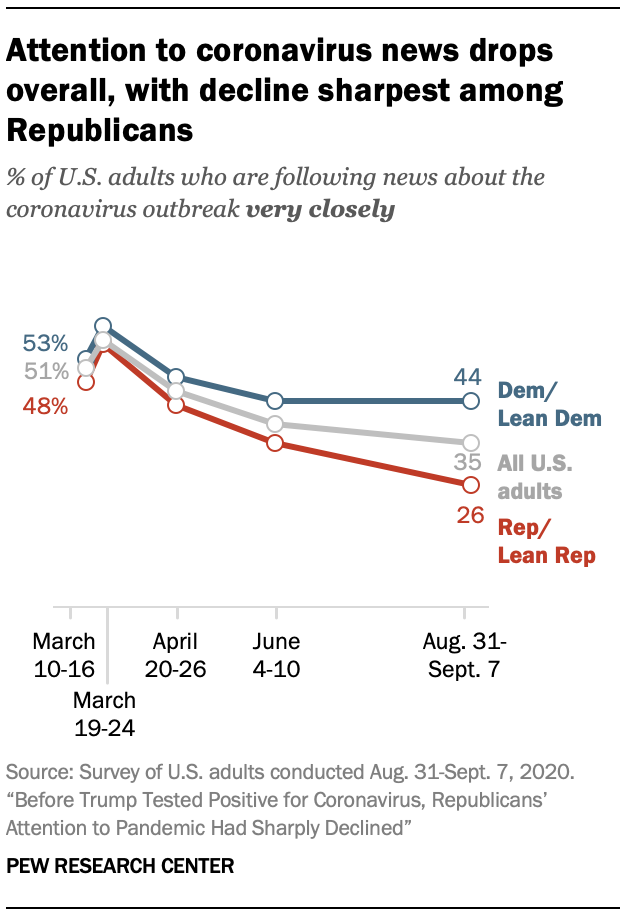 Republicans also are less likely than Democrats to be highly engaged with news coverage of the pandemic. As of early September, about a quarter of Republicans (26%) say they are following news about the outbreak “very closely,” down substantially from the early days of the pandemic in the U.S., when more than half (56%) were highly engaged in late March. At that time, there were minimal differences between the parties on this measure; now, Democrats are 18 percentage points more likely than Republicans to say they are following news about the outbreak very closely (44% vs. 26%). Among all U.S. adults, the percentage following coronavirus news dropped from 57% in late March to 35% in September.
Republicans also are less likely than Democrats to be highly engaged with news coverage of the pandemic. As of early September, about a quarter of Republicans (26%) say they are following news about the outbreak “very closely,” down substantially from the early days of the pandemic in the U.S., when more than half (56%) were highly engaged in late March. At that time, there were minimal differences between the parties on this measure; now, Democrats are 18 percentage points more likely than Republicans to say they are following news about the outbreak very closely (44% vs. 26%). Among all U.S. adults, the percentage following coronavirus news dropped from 57% in late March to 35% in September.
Overall, interest in news about the outbreak has waned slightly, but remains high. In the September survey, 82% of U.S. adults say they are following coronavirus news either “very closely” (35%) or “fairly closely” (46%). That is down modestly from late March, when 92% were following very closely (57%) or fairly closely (35%).
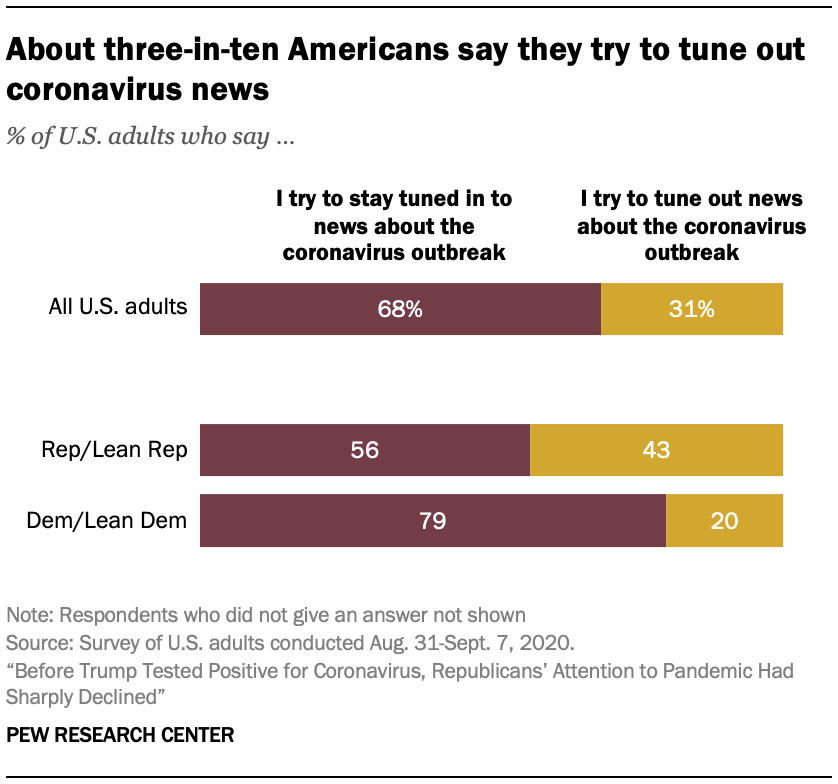 When it comes to COVID-19 coverage, some Americans seem to be trying to avoid the news: About three-in-ten (31%) say they try to tune out news about the coronavirus outbreak, with Republicans (43%) about twice as likely as Democrats (20%) to do this. But on the whole, most Americans (68%) say they are trying to stay tuned into news about the pandemic.
When it comes to COVID-19 coverage, some Americans seem to be trying to avoid the news: About three-in-ten (31%) say they try to tune out news about the coronavirus outbreak, with Republicans (43%) about twice as likely as Democrats (20%) to do this. But on the whole, most Americans (68%) say they are trying to stay tuned into news about the pandemic.
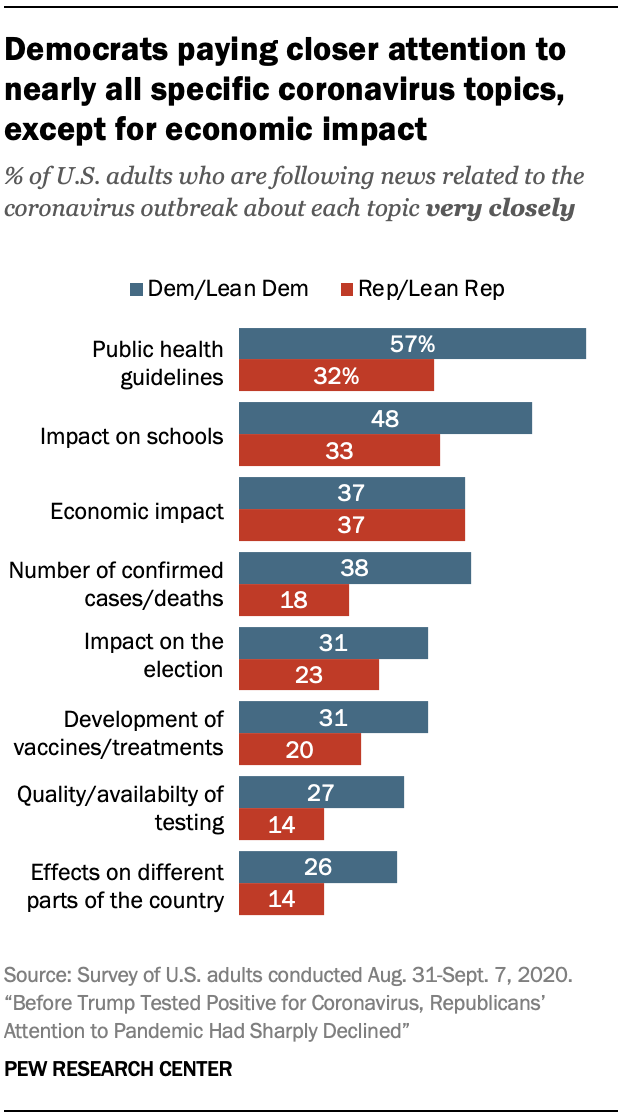 Partisan gaps in attention are also evident when Americans are asked about several specific topics related to the COVID-19 pandemic. Of the eight topics asked about in early September, Democrats are paying more attention than Republicans to seven of them – often by significant margins. The only topic on which there is no partisan gap concerns the outbreak’s economic impact.
Partisan gaps in attention are also evident when Americans are asked about several specific topics related to the COVID-19 pandemic. Of the eight topics asked about in early September, Democrats are paying more attention than Republicans to seven of them – often by significant margins. The only topic on which there is no partisan gap concerns the outbreak’s economic impact.
For example, Democrats are about twice as likely as Republicans (38% vs. 18%) to say they are following the number of confirmed COVID-19 cases and deaths very closely. On the topic of the quality and availability of testing, 27% of Democrats are following very closely, compared with 14% of Republicans. And when it comes to general public health guidelines about the virus, a majority of Democrats (57%) say they are following very closely; just about a third of Republicans (32%) say the same.
Within both parties, those with a mixed diet of news sources are paying the most attention to COVID-19 news
Aside from partisan differences, there are also differences within each party based on media diets.
In this report, Republicans are divided into a few groups: those whose major news sources consist only of outlets with right-leaning audiences (Fox News and talk radio); those who use a mix of sources with right-leaning audiences and other major sources; and those who rely on at least one of the eight sources, but not Fox News or talk radio. For Democrats, the groups include those who use only the major sources with left-leaning audiences (i.e., MSNBC, CNN, NPR, New York Times and Washington Post); those who use a mix of these and other major sources; and those who name only sources without left-leaning audiences as a major source for political news. In both parties, there is a final group that says none of the eight sources for political and election news are major sources; this group is far less engaged overall. (See Appendix for more details about this methodology.)
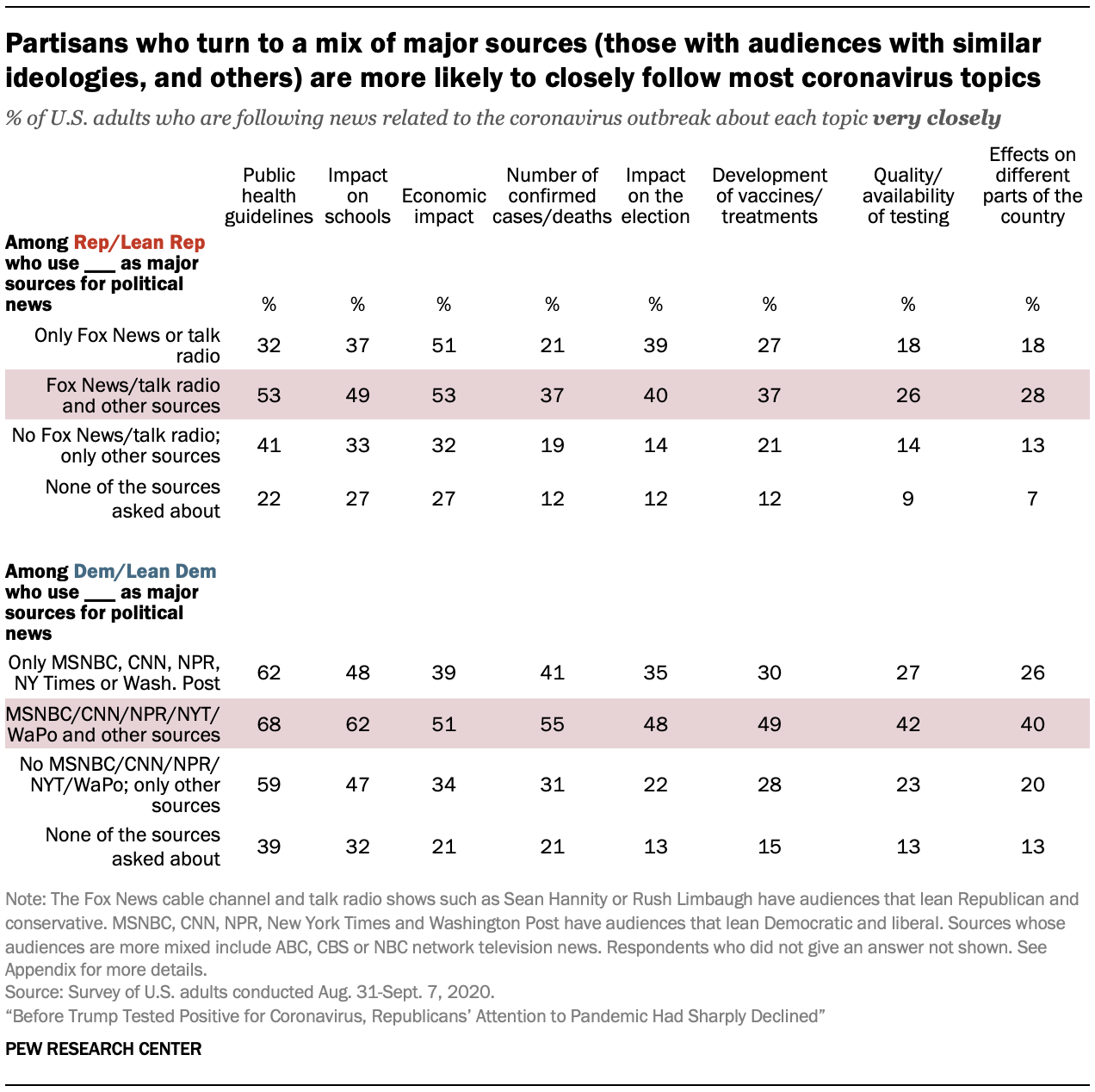
In each party, those who use a mix of major sources – ones with ideologically similar audiences and ones without – are most likely to say that they are following coronavirus news very closely. Among Republicans, 45% of those who use a mix of major sources are following pandemic news very closely as of early September, compared with 33% who only rely on sources with a right-leaning audience and 27% of those whose major sources don’t include any with a right-leaning audience. Among Democrats, 59% of those who rely on a mix of sources are following very closely, compared with 49% who turn only to sources with a left-leaning audience and 40% in the group whose major sources don’t include any with a left-leaning audience.
The same pattern holds across most of the eight specific topics related to coronavirus news. For example, the percentage of Republicans who turn to a mix of sources who are following news about COVID-19 cases and deaths very closely (37%) is substantially larger than the portion among those who rely on only sources with right-leaning audiences (21%) or only sources without a right-leaning audience (19%). And about half of Democrats who use a mix of sources (55%) are following the confirmed COVID-19 cases and deaths very closely, vs. 41% of Democrats who rely on only major sources with left-leaning audiences and 31% who rely on only major sources without left-leaning audiences.
On the subject of the outbreak’s impact on schools, 49% of Republicans with a mix of major sources are following very closely, compared with 37% who rely on only major sources that have a right-leaning audience and 33% of those who rely on only major sources without right-leaning audiences. Among Democrats, 62% with a mixed media diet are following that topic closely, compared with 48% using only major sources with a left-leaning audience and 47% who only turn to major sources without a left-leaning audience.
Republicans and Democrats differ on how difficult they say it is to sort truth from fiction in coronavirus news
 Americans overall are about evenly split over whether it has become harder or easier to distinguish truth from falsehoods about the coronavirus outbreak since the early days of the pandemic. While 38% of U.S. adults say that as of early September they are finding it harder to identify what is true and what is false, an almost identical share (36%) say they are finding it easier. The remainder (26%) say it hasn’t changed much in either direction.
Americans overall are about evenly split over whether it has become harder or easier to distinguish truth from falsehoods about the coronavirus outbreak since the early days of the pandemic. While 38% of U.S. adults say that as of early September they are finding it harder to identify what is true and what is false, an almost identical share (36%) say they are finding it easier. The remainder (26%) say it hasn’t changed much in either direction.
Again, there are differences between the two major parties on this question.
Nearly half of Republicans (49%) say it is harder to determine what is true compared with the first weeks of the outbreak. That is substantially more than the 29% of Republicans who say it is easier and the 22% who say there has been no change.
But Democrats are more likely to say it has become easier (42%) rather than harder (30%) to discern the truth about the outbreak. Another 28% say there has been no change.
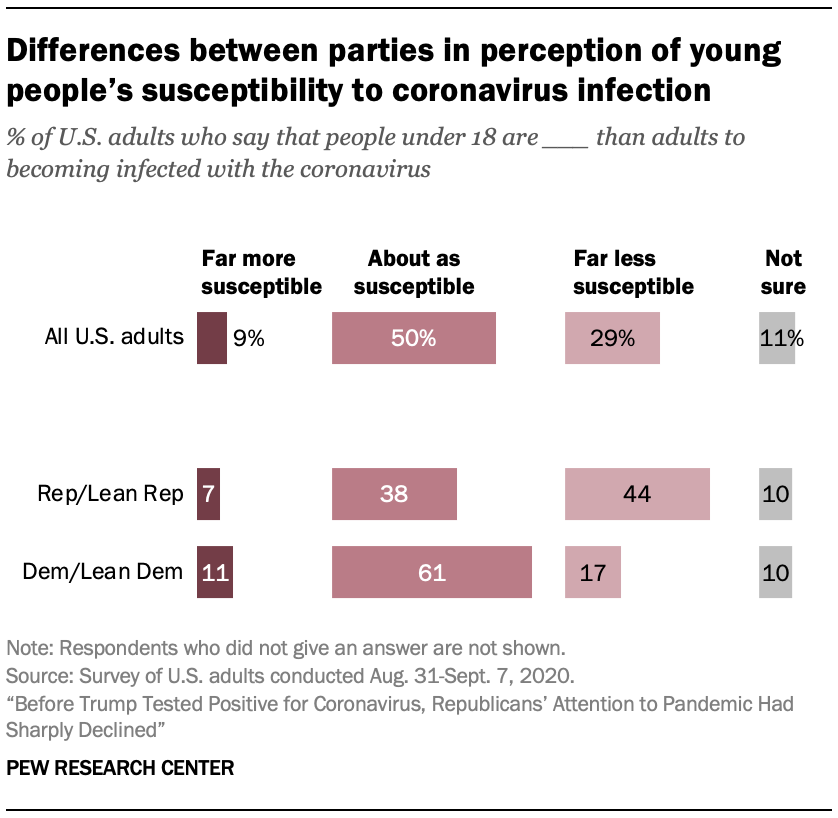 One specific area of disagreement is how susceptible young people (under the age of 18) are to becoming infected with the virus, a debate that often surfaces in discussions over whether and when to reopen schools for in-classroom learning.
One specific area of disagreement is how susceptible young people (under the age of 18) are to becoming infected with the virus, a debate that often surfaces in discussions over whether and when to reopen schools for in-classroom learning.
There is no strong evidence that younger people are less likely than adults to be infected with the virus, though there are differences by age in likelihood of death and severity of symptoms.
Overall, half of U.S. adults say that people under 18 are about as susceptible as their elders to becoming infected with the coronavirus, while 29% say that minors are far less susceptible. Just 9% say that young people are far more susceptible, while 11% say they are not sure.
A majority of Democrats (61%) say that those under 18 are about as susceptible as adults, with 17% saying they are far less susceptible and 11% saying they are far more susceptible. In contrast, a plurality of Republicans (44%) say young people are far less susceptible than adults, modestly more than the 38% who say they are about as susceptible.
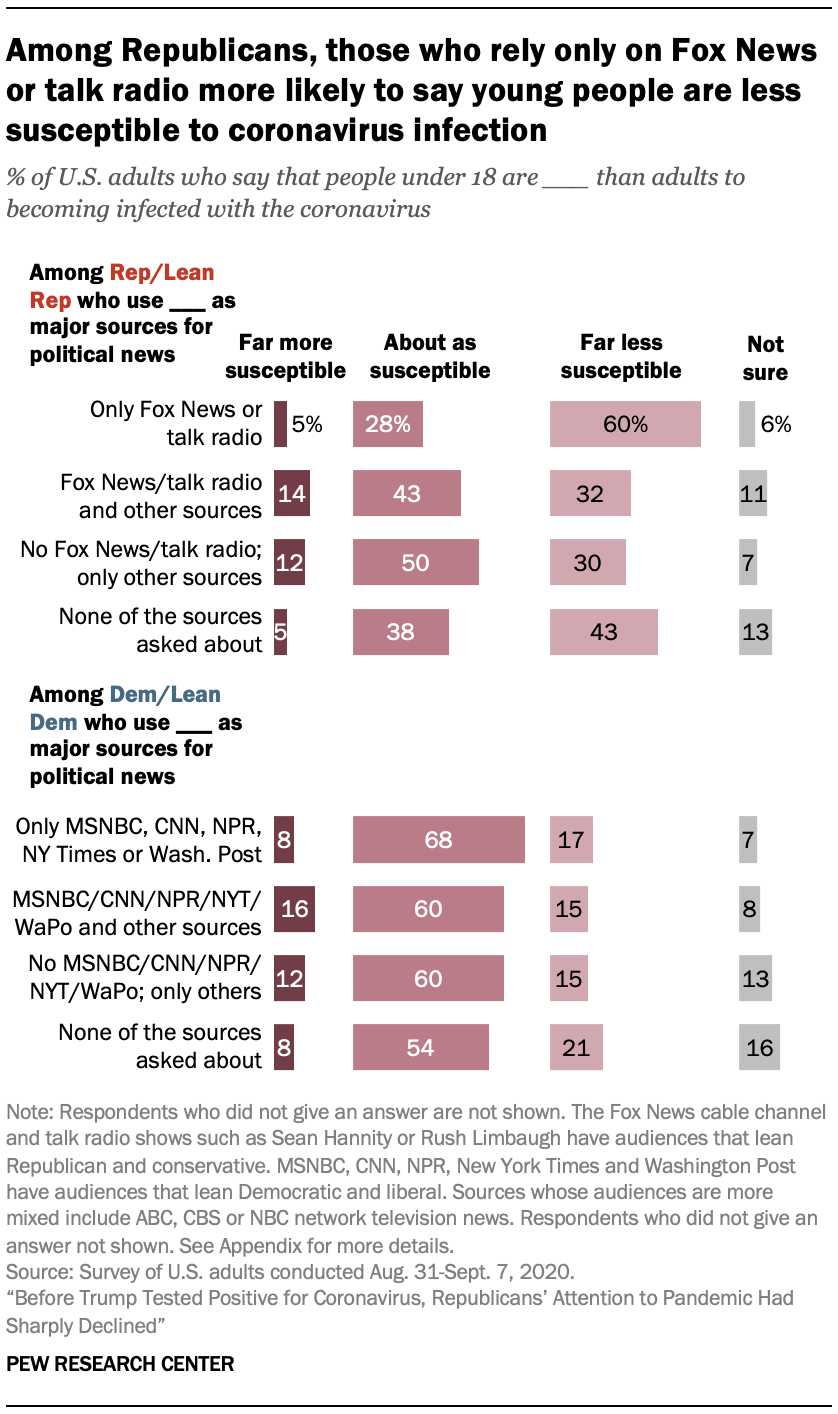 There are only small differences in responses to this question among Democrats who use different major sources for political news. But among Republicans who use only Fox News and/or talk radio as their major sources, a majority (60%) say that minors under 18 are far less susceptible, compared with far fewer among Republicans who use a mixed media diet (32%) or only major sources without conservative-leaning audiences (30%).
There are only small differences in responses to this question among Democrats who use different major sources for political news. But among Republicans who use only Fox News and/or talk radio as their major sources, a majority (60%) say that minors under 18 are far less susceptible, compared with far fewer among Republicans who use a mixed media diet (32%) or only major sources without conservative-leaning audiences (30%).
"had" - Google News
October 07, 2020 at 11:08PM
https://ift.tt/34w3q4Q
Republicans' Attention to COVID-19 News Had Declined Before Trump Tested Positive - Pew Research Center's Journalism Project
"had" - Google News
https://ift.tt/2KUBsq7
https://ift.tt/3c5pd6c
Bagikan Berita Ini














0 Response to "Republicans' Attention to COVID-19 News Had Declined Before Trump Tested Positive - Pew Research Center's Journalism Project"
Post a Comment